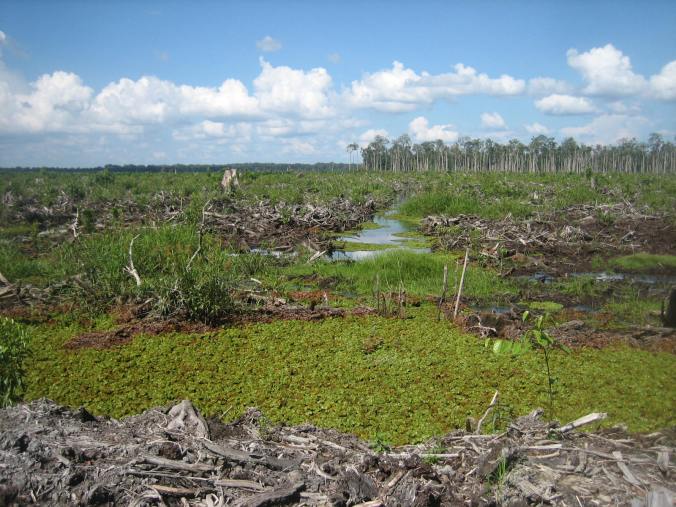In case you missed the build-up and outcome of the Indonesian Peat Prize, here’s a recap on it that was published last week in Peatlands International, written by Lydia Cole.
After much anticipation, on World Wetlands Day in February of this year, the winning team of the Indonesian Peat Prize was revealed. With two years from launch to completion, spanning a period of new and recurring outbreaks of fire in the country, controversial instructions on the use of peatland concessions and growing international pressure to divest funds from the palm oil industry, this announcement is much welcomed. But what is the Indonesian Peat Prize? Who are the winners? And importantly, how might it contribute to tropical peatland conservation?

An area of deforested, drained and burnt peatland, converted into smallholder agriculture, within a Biodiversity Concession, Central Kalimantan province. Mapping of these activities, and the depth of peat on which they are happening, will assist with planning more responsible landscape management.
What is the Indonesian Peat Prize?
After the devastating peat fires of 2015, creating a toxic haze that covered parts of Southeast Asia for months, the spotlight was on Indonesia to address the cause of the burning. Unsustainable land use in peatland areas was the primary offender, whether resulting from activities of industrial-scale oil palm and pulp and paper companies, smallholders, or a mixture of both. Who exactly is to blame varies by place and perspective; further discussion of which will be left for another day! In order to address this international disaster and restore the burnt landscapes, the Indonesian Government established the Peatland Restoration Agency, or BRG, in January of 2016.
Before the BRG could address the challenge of understanding the distribution of peatland (mis)uses and consider where to restore the ecosystem, there was a need to know where the peat actually is, and crucially, how deep it is. There was already a map of peatland distribution in Indonesia: Wetlands International compiled one in 2004 and the Ministry of Agriculture in 2011, which can be accessed through the Global Forest Watch platform. However, these maps offer a very coarse spatial resolution and an even coarser indication of how thick the peat is. Since their production, earth observation and ground-based technologies have improved dramatically, making higher resolution mapping more feasible.
Cue the Indonesian Peat Prize. The David and Lucile Packard Foundation provided one million USD to the Indonesian Government’s Geospatial Information Agency (BIG) with which to launch an international competition with the primary goal of developing a “fast, accurate and cost-effective way to map Indonesia’s vast tropical peatlands”. The open competition had been bubbling away since February 2016, with a selection of finalists being put through their paces over the last six months. But there could only be one winner!
And the winner is ….
The winning team is an international collaboration of scientists (mostly men!), coming from Indonesia, Germany and the Netherlands. The aptly named International Peat Mapping Team (IPMT) comprises members from Indonesia’s Agency for the Assessment and Application of Technology (BPPT), South Sumatra province’s Sriwijaya University, and three German institutions: Greifswald University, the Remote Sensing Solutions GmbH (RSS) and Airbus DS Geo. They convinced the judges of their ability to create a prototype method for surveying the country’s peatlands, with their proposed “multistage” solution: a cost-effective, versatile combination of satellite remote sensing, airborne LiDAR and ground-based measurements. Though this group was awarded the prize, other finalists proposed using similar techniques (with the possibility of lower costs) which may also form part of the solution as the exercise unfolds.
-

A new oil palm plantation under development, at the edge of a protected peatland (with remnant peat swamp forest visible in the background). How far into the peat dome the plantation extends, and thus the extent of impact, will be measurable using the new mapping techniques.
How might the prize help peat?
In theory, the map will create a universal, repeatable method for mapping peatlands across Indonesia (and potentially the world). Having One Map from which land covers can be defined and land uses observed and allocated will enable a greater transparency in local and national government decision-making. It may also help to reduce the regular conflict encountered when land management decisions are made without complete information on land use and tenure.
In practice however, a lot of money has been spent on a mapping exercise that will only mean anything if there is money to spend on the management exercise to accompany it. The conservation challenge on the ground is likely less to do with knowing the exact depth of a peat substrate and more to do with the depth of understanding of the people living there of how important maintaining a wet peatland is; coupled with the depth of understanding of the challenges and aspirations of those people by the institutions proposing sustainable management policies. The cost of understanding the extent of the challenge, of figuring out how to restore such a transformed landscape and of enforcing the variety of potential policy solutions must not be underestimated.
Nazir Foead, the Head of the BRG, tasked with one of the most challenging jobs in the world, is “optimistic that the agency will complete the restoration program [of over 2 million hectares] by 2020“. To put this into perspective, the UK has committed to having two million hectares of restored or sustainably managed peatlands by 2040, and that will likely be a struggle despite the growing funds available, the restoration expertise sourced from across the northern hemisphere and the level of national support (in the most part). But the political commitment and transparency shown by Indonesia is admirable, and strongly welcomed at this critical point in the story of tropical peatlands.
Congratulations to the winners; good luck to the BRG. Your work is just beginning!